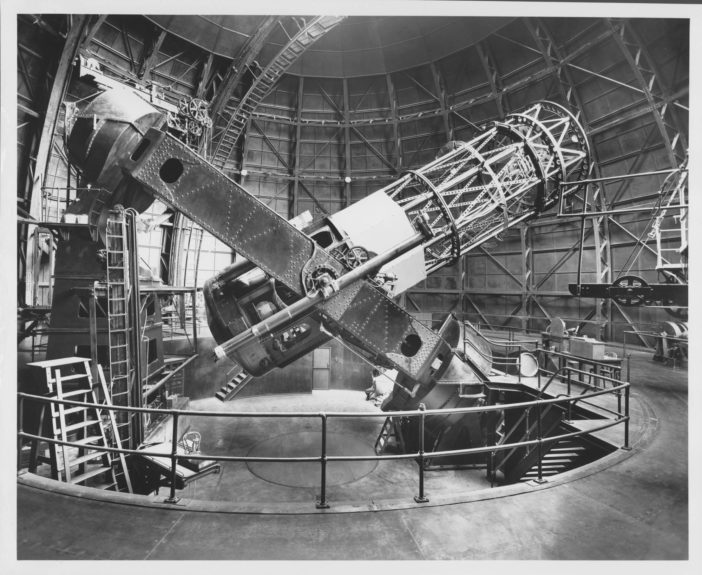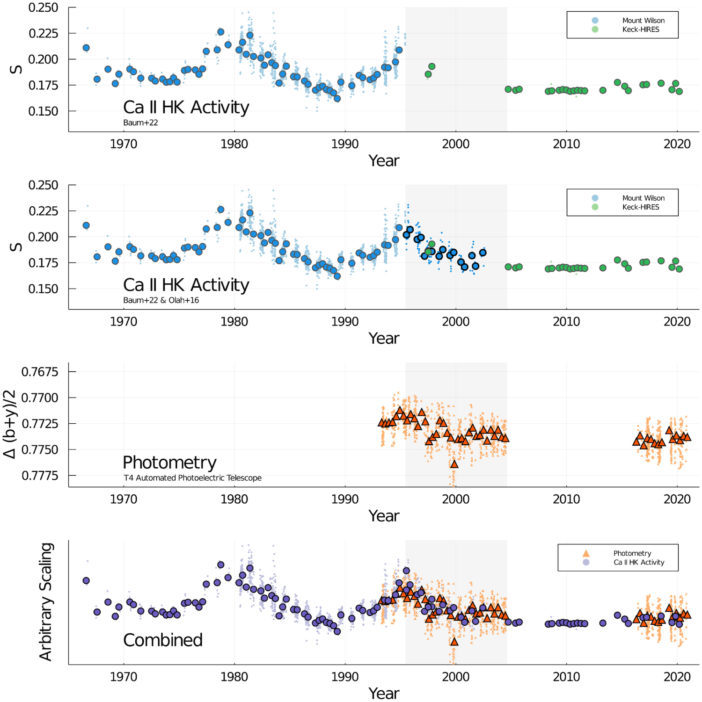Editor’s Note: Astrobites is a graduate-student-run organization that digests astrophysical literature for undergraduate students. As part of the partnership between the AAS and astrobites, we occasionally repost astrobites content here at AAS Nova. We hope you enjoy this post from astrobites; the original can be viewed at astrobites.org.
Title: HD 166620: Portrait of a Star Entering a Grand Magnetic Minimum
Authors: Jacob K. Luhn et al.
First Author’s Institution: University of California, Irvine
Status: Published in ApJL
Have you ever gazed at the Sun using a pinhole viewer? With only tape, a piece of foil, and a thumbtack, you can turn an old shoe box into a simple telescope that creates a projection of our parent star that’s safe to view. At first, the image it creates might look just like a smooth disk, but if you look closer, you can see smudges moving across it — sunspots! These dark, transient features are cooler parts of the Sun’s surface that correspond to areas with strong magnetic activity. If you had a really, really good pinhole viewer and a few decades of spare time, you might notice that the average number of sunspots slowly changes.
Usually these changes repeat every 11 or so years in what we call the solar cycle, and the changes in the number of sunspots are accompanied by variations in flares and other coronal activity. Once in a while, though, something weird happens. Records show that between 1645 and 1715, the Sun went through a long period with very few sunspots, an event that astronomers call the Maunder Minimum. It’s really, really weird, and so you might wonder: do other stars do the same thing? Today’s article presents new data on the Sun-like star HD 166620, for which the answer seems to be yes!
Like the Sun, HD 166620 exhibits long, slow cycles of activity, and so to show that it’s entering its own Maunder Minimum, the team needed decades of data. Fortunately, there are troves of observations by the Mount Wilson Observatory (Figure 1) from 1966 to 1995 on HD 166620 and a slew of other stars, as well as newer observations by the Keck-HIRES spectrograph from 2004 to 2020. These data track a particular type of emission from calcium atoms in the star’s outer layers — a good proxy for stellar activity, including sunspot numbers. Stronger emission correlates with more stellar activity.

Figure 1: The 100-inch Hooker telescope is best known for its use by Edwin Hubble in the 1920s to show that the universe is expanding, but it also provided data for the first decade of the Mount Wilson calcium survey, used by the authors of today’s article to provide evidence of HD 166620’s previous cycles. [Image courtesy of the Observatories of the Carnegie Institution for Science Collection at the Huntington Library, San Marino, California.]
That’s where today’s article comes in. The team found more Mount Wilson data on calcium emission, this time covering the range from 1995 to 2002. What’s more — tada! — these observations show a smooth, satisfying transition from the star’s cycle to this new low-activity state. In addition, the team obtained photometry from the T4 Automated Photometric Telescope. These measurements of the star’s brightness, taken from 1993 to 2005 and 2015 to 2020, complement the measurements of calcium emission and show the exact same trend. It is, as the authors put it, “unambiguous” evidence that HD 166620 is entering a Maunder Minimum–like period (see Figure 2).

Figure 2: Four plots illustrating the datasets the team used. The top includes only the previously published spectroscopic calcium measurements, while the second adds in the newly found observations. The third shows only the photometric data, while the fourth shows everything combined — a clear demonstration that HD 166620 has entered a longer duration minimum. [Luhn et al. 2022]
Long-term surveys can turn up some interesting trends — and the decades of Mount Wilson data on HD 166620 have uncovered a new first. Several other stars have been proposed as candidates for entering or exiting these grand minima; hopefully, with the knowledge gained from the study of HD 166620’s calcium emission and photometry, we’ll soon have a clearer understanding of how these processes work and how common these phenomena are.
Original astrobite edited by Konstantin Gerbig.
About the author, Graham Doskoch:
I’m a graduate student at West Virginia University, pursuing a PhD in radio astronomy. My research focuses on pulsars and efforts to use them to detect gravitational waves as part of pulsar timing arrays like NANOGrav and the IPTA. I love running, hiking, reading, and just enjoying nature.
